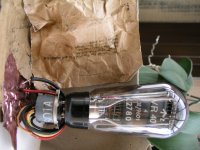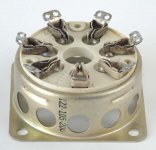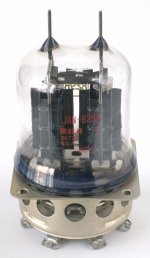Long time ago, I heard nothing was better than ceramics. Some military NOS tube sockets are made from ceramics/porcelain.
Nowadays, most expensive sockets are made from Teflon. Even porcelain is not a standard. And there is a brown material like plastic that is even more expensive than porcelain.
Anybody knows about socket material quality or characteristics? I have some porcelain sockets that I may or may not use in my project, depending on the information.
Nowadays, most expensive sockets are made from Teflon. Even porcelain is not a standard. And there is a brown material like plastic that is even more expensive than porcelain.
Anybody knows about socket material quality or characteristics? I have some porcelain sockets that I may or may not use in my project, depending on the information.
From what I know teflon is one of the highest grade insulators available, but for the money I've seen these sockets advertised for it's not worth it. Also, porcelain is a high quality insulator all in itself and quite affordable, so I stick to it. As for the other sockets you mentioned, they are most like NOS bakelite sockets, please correct me if I'm wrong on this. Overall, ceramic is the way to go.
Bakelite! Yes, that's what they call it. Some audiophiles tried to convince me that bakelites are better than ceramics. They talked about distortion (or harmonics) created by the ceramics.
I got the feeling that the ceramics were okay, or at least not so bad that I have to buy new sockets to replace something I already have at hand. Thanks, I think I will solder the ceramics tonight...
I got the feeling that the ceramics were okay, or at least not so bad that I have to buy new sockets to replace something I already have at hand. Thanks, I think I will solder the ceramics tonight...
Amphenol is a brand, not a plastic. You're probably thinking of phenolic.
The best material is indeed ceramic. Temperature resistant, low loss at RF, great mechanicals. Teflon is an excellent dielectric, but soft and not as refractory. Bakelite is... nostalgic. Phenolic is the same stuff used to make cheap fishplate circuit boards.
I'd agree with Frank, though- quality of contacts is the number one consideration in specifying a socket. As a side note, there was an amp manufacturer who made a big deal out of eliminating the sockets and soldering in their output tubes. Of course, what went unsaid was that the satellite circuit board to hold the output tubes was connected to the rest of the circuit by, yes, you guessed it, a connector.
The best material is indeed ceramic. Temperature resistant, low loss at RF, great mechanicals. Teflon is an excellent dielectric, but soft and not as refractory. Bakelite is... nostalgic. Phenolic is the same stuff used to make cheap fishplate circuit boards.
I'd agree with Frank, though- quality of contacts is the number one consideration in specifying a socket. As a side note, there was an amp manufacturer who made a big deal out of eliminating the sockets and soldering in their output tubes. Of course, what went unsaid was that the satellite circuit board to hold the output tubes was connected to the rest of the circuit by, yes, you guessed it, a connector.
Contacts: Some modern sockets have very poor contacts, but so long as your valves don't go in and out like a sailor on shore leave, this shouldn't be too much of a problem. Johnson made sockets with superb contacts.
Insulation: Brown and black phenolic sockets are leaky and can allow noise currents to flow from anode to grid. Ceramic and PTFE are measurably close to perfect.
Insulation: Brown and black phenolic sockets are leaky and can allow noise currents to flow from anode to grid. Ceramic and PTFE are measurably close to perfect.
SOME ENGINEERS YOU KNOW.
Hi,
Yup, I know which one you mean and NO I won't mention their name...too silly idea and all they wanted was to reduce manufacturing costs IMO.
Sound was nothing to write home about anyway and engineering too shortsighted to be worth mentioning...
In Europe at least Amphenol sockets are very common amongst tube-o-philes, in fact so much so that their phenolic insulators have become almost Coca Cola like in parlance amongst insiders.
I personally go for PTFE sockets (the British army ones) for small signal apps and ceramic for power apps, contact quality being good on both counts that is.
Cheers,
Hi,
Of course, what went unsaid was that the satellite circuit board to hold the output tubes was connected to the rest of the circuit by, yes, you guessed it, a connector.
Yup, I know which one you mean and NO I won't mention their name...too silly idea and all they wanted was to reduce manufacturing costs IMO.
Sound was nothing to write home about anyway and engineering too shortsighted to be worth mentioning...
Insulation: Brown and black phenolic sockets are leaky and can allow noise currents to flow from anode to grid. Ceramic and PTFE are measurably close to perfect.
In Europe at least Amphenol sockets are very common amongst tube-o-philes, in fact so much so that their phenolic insulators have become almost Coca Cola like in parlance amongst insiders.
I personally go for PTFE sockets (the British army ones) for small signal apps and ceramic for power apps, contact quality being good on both counts that is.
Cheers,
hi all,
i think the most important is the contact pins that can best contact or not. I agree that china made is not ggod. If U want I make a choose, i will choose NOS EF Johnson ceramic one or expensive Japan made telfon/The high stardard telfon & the pin use solid copper to raw the sharp with 24K gold plate. the pins was a cone sharp.
I feel that this is good but $$$$$$$.
thanks
Thomas







i think the most important is the contact pins that can best contact or not. I agree that china made is not ggod. If U want I make a choose, i will choose NOS EF Johnson ceramic one or expensive Japan made telfon/The high stardard telfon & the pin use solid copper to raw the sharp with 24K gold plate. the pins was a cone sharp.
I feel that this is good but $$$$$$$.
thanks
Thomas







I occasionally use ceramics, but mainly use old NOS bakelite sockets, simply because I have them available. I've never had a problem with the quality of the contacts, but one rider I would say that if you are using these type of sockets in experimental circuits using octals or loctals in which you constantly change the tubes, they are physically more likely to break down.
I used to have some old computer panels from an early tube computer, and these had double triode type tubes soldered directly into the panels to improve electrical contacts.
I used to have some old computer panels from an early tube computer, and these had double triode type tubes soldered directly into the panels to improve electrical contacts.
hi bournville,
I think U say the old tube computer is the old we or hp old computer or the old telephone building or cinema use. Certainly they were very good.
i give U see one item for PX25 use. Its made by in company call Emerson Radio & photograph corp.
Its prefect contact. i & my friend like it most.
As U said U use NOS socket. They were best, I feel that the quatity is better than the new one.
thanks
Thomas
I think U say the old tube computer is the old we or hp old computer or the old telephone building or cinema use. Certainly they were very good.
i give U see one item for PX25 use. Its made by in company call Emerson Radio & photograph corp.
Its prefect contact. i & my friend like it most.
As U said U use NOS socket. They were best, I feel that the quatity is better than the new one.
thanks
Thomas
Attachments
SY said:That looks like a socket for a forced-air-cooled transmitting tube.
Yes, it's for the Septar-based 829B
Attachments
Hi Sy;
>>>...Bakelite is... nostalgic. Phenolic is the same stuff used to make cheap fishplate circuit boards....<<<
No offense intended, but if I recall correctly "bakelite" and "phenolic" are more or less synonymous in this usage, with "bakelite's" name being a derivative of the original inventor's. Bakelite is a condensation polymer of phenol and formaldehyde. There are different grades of bakelite, based on the additives to it (things like wood fibres, etc), that are heated under pressure with the bakelite resin. It's the additives and the crosslinking between polymer chains that occurs with heat and pressure that give bakelites their colour and strength - without them, bakelite resin is a brittle amber coloured material.
All the best,
Morse
>>>...Bakelite is... nostalgic. Phenolic is the same stuff used to make cheap fishplate circuit boards....<<<
No offense intended, but if I recall correctly "bakelite" and "phenolic" are more or less synonymous in this usage, with "bakelite's" name being a derivative of the original inventor's. Bakelite is a condensation polymer of phenol and formaldehyde. There are different grades of bakelite, based on the additives to it (things like wood fibres, etc), that are heated under pressure with the bakelite resin. It's the additives and the crosslinking between polymer chains that occurs with heat and pressure that give bakelites their colour and strength - without them, bakelite resin is a brittle amber coloured material.
All the best,
Morse
EC8010,
While the ceramic is nice, those pins are the absolute worst! The clips that make the tension are so prone to breaking or falling off, that you night as well use alligator clips.
And who of us doesn't like to swap tubes every so often to hear differences or just to customize the sound with the music or mood?
All others,
My personal favorites... not for nostalgia... are the Amphenol brand bakelites... brown in color, not black, especially for the four pin 300Bs. Again, that is because of construction quality, strength and pin quality. There is a brand I got from Angela Instruments called QQ. They are very decent also.
The only ceramics I have gotten worth the 3 bucks each are from Uncle Ned (Triode Electronics) with gold pins. I would love to use ceramics all over because of their high voltage dielectric quality, but if they would only make decent pins...
Every other ceramic socket I had tried had horrible pins.
My opinion, FWIW.
Gabe
While the ceramic is nice, those pins are the absolute worst! The clips that make the tension are so prone to breaking or falling off, that you night as well use alligator clips.
And who of us doesn't like to swap tubes every so often to hear differences or just to customize the sound with the music or mood?
All others,
My personal favorites... not for nostalgia... are the Amphenol brand bakelites... brown in color, not black, especially for the four pin 300Bs. Again, that is because of construction quality, strength and pin quality. There is a brand I got from Angela Instruments called QQ. They are very decent also.
The only ceramics I have gotten worth the 3 bucks each are from Uncle Ned (Triode Electronics) with gold pins. I would love to use ceramics all over because of their high voltage dielectric quality, but if they would only make decent pins...
Every other ceramic socket I had tried had horrible pins.
My opinion, FWIW.
Gabe
I think we may be entering personal opinion territory here. I like the look of those contacts, and I am told by those whose opinions I respect, that not using those contacts causes problems when the valve is used for its intended purpose as a 2m (144MHz) transmitter. So far, I've only had contact problems on nasty old phenolic-based B9A sockets. (I don't mean NOS sockets, but the ones on 30 year-old kit.)
I'm afraid I don't whip valves in and out if I can avoid it. My latest behemoth is grid biassed, and has a 3 1/2 digit DVM mounted adjacent to each output valve to monitor cathode current. I really don't want to change valves if I can avoid it - it takes time for the valves to settle...
I'm afraid I don't whip valves in and out if I can avoid it. My latest behemoth is grid biassed, and has a 3 1/2 digit DVM mounted adjacent to each output valve to monitor cathode current. I really don't want to change valves if I can avoid it - it takes time for the valves to settle...
- Status
- This old topic is closed. If you want to reopen this topic, contact a moderator using the "Report Post" button.
- Home
- Amplifiers
- Tubes / Valves
- Best Socket Material?


